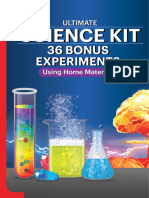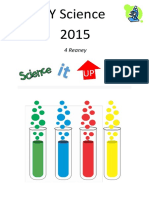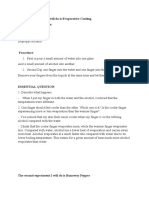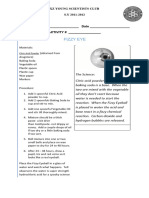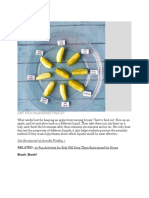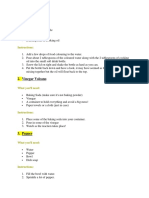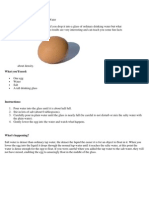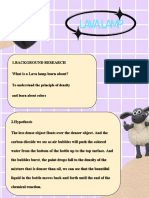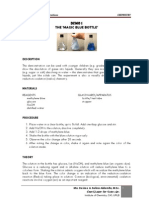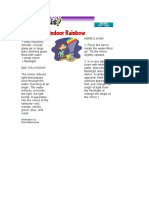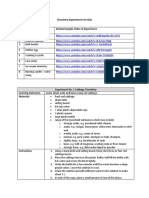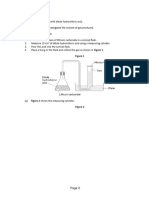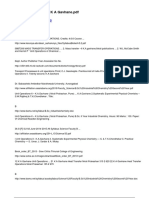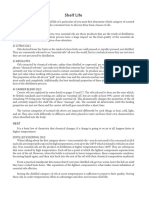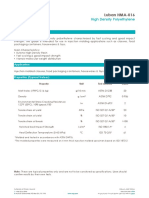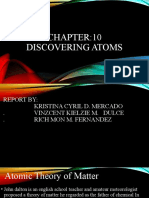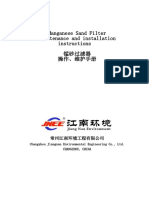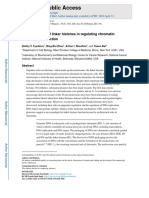INVISIBLE INK
Be a secret agent and write invisible ink messages using a few basic items you can find
around the house in this fun science experiment.
Materials Needed
● Cotton bud
● Lamp/light bulb/ flash light
● Plain white paper
● Bowl/cup
Procedure
1. Squeeze the lemon juice into a bowl or cup and mix in a few drops of water.
2. Dip the cotton bud into the mixture and use it to write a secret message onto the
white paper.
3. Allow the paper to dry and the juice to become invisible.
4. Reveal your secret message by holding it close to a light bulb/flash light.
Explanation
Lemon juice contains carbon compounds that are colourless at room temperature. The
heat from the light bulb breaks down the compounds and releases the carbon. The
carbon oxidises when it comes into contact with the air and turns brown, making your
invisible message visible under the hot light bulb.
�LAVA LAMP
The main idea for kids is the concept of density, in particular, the idea that things that
are more dense than a liquid sink and things that are less dense than a liquid float. This
activity is interesting because gas is added to and taken away from big drops of water
which changes their density and causes them to float or sink in oil. Kids love watching
this version of a lava lamp because of the colorful blobs that are moving around. What
better way to teach kids about chemistry than to show them something that will
captivate them!
Materials Needed
● Vinegar
● oil
● Water
● Baking soda
● Tall clear plastic container (or jar)
● Food coloring (bright colors)
Procedure
1. Fill the bottle about 2/3 full with oil.
2. Add food coloring for color. You want it to be fairly dark but not too dark.
3. Fill the rest of the bottle with water, but don’t fill it to the brim.
4. Add a half or quarter of an Alka-Seltzer tablet to the bottle. Watch what happens!
Explanation
Before the Alka-Seltzer is dropped in the bottle, the oil floats on the colored water. Oil
floats because it is less dense than water. Oil and water don’t mix because water
molecules are not attracted to oil molecules.
When the Alka-Selzer tablet is dropped in the oil and water, it sinks to the bottom
because it is more dense than oil and more dense than the water. In the water layer, the
tablet begins to dissolve and the chemicals in the tablet react with each other creating
bubbles of carbon dioxide gas. When enough gas enters an area of water, the
waterand-gas combination in this spot becomes less dense than the water around it, so
�it floats up through the water. If this water-and-gas mixture is less dense than the oil, it
floats up through the oil too. Since the water is so attracted to itself and not to the oil,
the water-and-gas mixture moves through the oil in a ball-shape. Once a ball of
waterand-gas gets to the surface, some bubbles of carbon dioxide gas pop, releasing
the gas into the air. When enough bubbles pop, the water-and-remaining gas becomes
more dense than the oil. So the ball of water sinks down through the oil and joins the
rest of the water.
Changes in density as gas is added to or taken away from water cause it to float up and
sink down through the oil. Thus the lava lamp is created!
�TRAVELING FIRE
Relight a candle using the smoke. This is an experiment about the science of a burning
candle
Materials Needed
● 1 candle (the more smoke it emits when you blow it out, the better)
● 1 lighter or matchbox
Safety equipment:
● 1 fire extinguisher
Procedure
1. Light the candle.
2. Light the lighter or a match again, so you have a flame ready. Blow out the
candle. Hope for a compact streak of smoke.
3. Place the flame of the lighter or match in the smoke from the blown out candle.
4. With a little luck, the flame travels through the streak of smoke down to the
candle and lights it again!
Short Explanation
The smoke from a blown out candle is vaporized wax (or other constituents of the
candle). When a candle burns, it is in fact this evaporated wax that burns, and you can
easily light it on fire again. However, the fire spreads lightning fast down to the wick,
where there is a good supply of new wax that evaporates.
�COLORFUL MILK
Materials Needed
● Milk
● plate
● Liquid Food coloring (4 colors)
● Dishwashing soap
● Cotton swabs
Procedures:
1. Pour enough milk in the dinner plate to completely cover the bottom to the depth
of about 1/4". Allow the milk to settle.
2. Add one drop of each of the four colors of food coloring — red, yellow, blue, and
green — to the milk. Keep the drops close together in the center of the plate of
milk
3. Find a clean cotton swab for the next part of the experiment. Predict what will
happen when you touch the tip of the cotton swab to the center of the milk. It's
important not to stir the mix. Just touch it with the tip of the cotton swab.
4. Now place a drop of liquid dish soap on the other end of the cotton swab. Place
the soapy end of the cotton swab back in the middle of the milk and hold it there
for 10 to 15 seconds. Look at that burst of color! It's like the 4th of July in a bowl
of milk!
5. Add another drop of soap to the tip of the cotton swab and try it again.
Experiment with placing the cotton swab at different places in the milk. Notice
that the colors in the milk continue to move even when the cotton swab is
removed.
Explanation
Milk is mostly water, but it also contains vitamins, minerals, proteins, and tiny droplets of
fat suspended in solution. Fats and proteins are sensitive to changes in the surrounding
solution (the milk). The secret of the bursting colors is the chemistry of that tiny drop of
soap. Dish soap, because of its bipolar characteristics (nonpolar on one end and polar
on the other), weakens the chemical bonds that hold the proteins and fats in solution.
�The soap's polar, or hydrophilic (water-loving) end dissolves in water, and its
hydrophobic (water-fearing) end attaches to a fat globule in the milk. This is when the
fun begins.
The molecules of fat bend, roll, twist, and contort in all directions as the soap molecules
race around to join up with the fat molecules. During all of this fat molecule gymnastics,
the food coloring molecules are bumped and shoved everywhere, providing an easy
way to observe all the invisible activity. As the soap becomes evenly mixed with the
milk, the action slows down and eventually stops.
�WATER MOLECULES ON THE MOVE
Materials Needed
● A clear glass filled with hot water
● A clear glass filled with cold water
● Liquid Food coloring
Procedures
1. Fill the glasses with the same amount of water, one cold and one hot.
2. Put one drop of food coloring into both glasses as quickly as possible.
3. Watch what happens to the food colouring.
Explanation
Heat is a form of energy. The heat energy from the water makes the water molecules in
the hot water move faster than the water molecules in the cold water. The faster moving
molecules in the hot water bump into the food coloring molecules more often and with
more force and move them all around faster than the slower moving water molecules in
the cold water.



